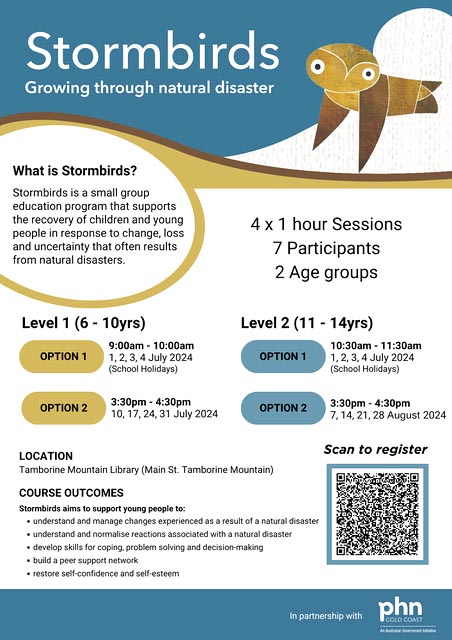The Mountain’s Continuing Path to Recovery
Six months on from the devastating Christmas Day weather event, Tamborine Mountain residents are still feeling the effects. While some lost their homes, others are still waiting on repairs and experiencing issues with their insurance providers. The impact is long-lasting and far-reaching, as the psychological toll has left many people fearing the next natural disaster. But are we prepared for that eventuality?
Clare Wray and her husband, Josh, were pivotal in providing practical aid in the storm’s aftermath, utilising their generator knowledge and chainsaw skills. Inspired by the clear up operation, Clare, a QUT Master’s student, has chosen to focus her research on building community resilience against natural disasters. The decision to turn her experience into academic inquiry has helped deepen her understanding of local dynamics.
Throughout the course of her work, Clare has discovered that, whereas residents once heavily relied on their government to respond effectively in times of extreme crisis, operating under an assumed social contract, the aftermath of the storm revealed a marked shift in perspective.
“It’s true that people have been compliant and trusting in higher authorities until fairly recently,” observes Clare. “Studies have shown that the more a government or entity knows of and promotes the fact that there is a risk, the less people are inclined to take ownership of it … It’s almost as if we think, ‘If you know that something devastating is likely to occur, then it’s your job to protect us.’”
However, as roads to the mountain were blocked and deemed unsafe soon after the disaster, coupled with extensive power outage, it became evident that individuals could not solely rely on the Council or emergency services to perform miracles.
Clare explains, “People are slowly realising that we need to revert to a village mentality, encourage others to get involved, be invested, and therefore ultimately empowered.”
Guy Johnstone, a resident for over two decades, witnessed first-hand the profound helplessness that swept through the community during the extended power cut, when lines where down and pumps were disabled, leaving many homes without water. He was one of the key individuals who set up a group of volunteers known as The Chainsaw Warriors, and went out of his way to assist those in need.
Guy reflects on the challenges faced in the immediate aftermath: “The main issue was that with electricity out, we couldn’t use our mobile phones and had no access to the internet – so most people were unable to call for help. I was lucky; my landline was working,” explains Guy. “But what became clear was that there was a disconnect within our community. Sure, we have social media, but until the Christmas Day storm, people had no idea who to turn to for assistance. It’s gotten better, but we shouldn’t be complacent and continue to expect the same key individuals with know-how to always come to the rescue.”
To remedy this, Guy advocates for the introduction of community workshops where residents can gather to learn generator maintenance, emergency communication, first aid, and basic survival techniques.
Echoing Guy’s sentiment, Clare suggests that newcomers receive welcome packs when moving here, containing crucial information about the area, and community resources. “We need these people to not only be aware of and appreciate the risks of living in this semi-rural environment, but to connect socially and strengthen bonds to the place.”
SEQ Transition Lead, Michelle Holweg, is working in collaboration with Scenic Rim Regional Council, spearheading the recovery initiative from the Christmas 2023 Storm. Tapping into the diverse knowledge and experience of local residents, she plans to develop a comprehensive community disaster management plan.
Michelle explains, “The purpose of this plan is to create a document outlining detailed arrangements to help the people of Tamborine Mountain effectively minimise the impacts of a disaster.” She added, “We need to assess how connected local people, groups, and businesses are within the community and determine what external assistance they believe would be most valuable for an effective recovery.”
Local resident Nadine Newton is in support of the plan. She saw the effect the storm had on our younger population. Thanks to a grant from the Gold Coast Primary Health Network, she is offering the Stormbirds program, designed specifically to help children who have gone through a natural disaster.
This initiative is a prime example of how local efforts are addressing specific community needs, setting a precedent for integrated and targeted support. Clare aims to highlight this approach in her upcoming presentation on July 6th at the Vonda Youngman Centre. There, she will examine the need to leverage local expertise and foster self-reliance among residents.
“Scenario planning brings people’s strengths into focus,” declares Clare, who goes on to describe how many underestimated their abilities to help after the storm. “Women were saying, ‘I can’t do the physical stuff, but I can make sandwiches.’ What became apparent was that all these ladies feeding the troops became the nerve centres of the operations. They would query the whereabouts of the vulnerable members of the community, which in turn would prompt others to go check on these isolated individuals.”
As Tamborine Mountain continues to heal and rebuild, the lessons learned about collective strength and proactive preparation will undoubtedly shape its path forward, making it not just a place of natural beauty, but a model of community resilience.
By Sharon Joslyn (Local Writer)
